Cactus Plants: How to Grow and Care For These Prickly Greens
Gardening experts offer their best tips for thriving succulents.
If you’re looking for low-maintenance and striking greenery, cactus plants are perfect. They’ve become popular for accentuating homes and gardens without much maintenance. “Cacti are incredibly popular for a good reason—they’re uniquely adapted to thrive in arid environments, requiring little water and withstanding high temperatures,” says Alex Worley, a certified master gardener and owner of Gardenine.com.
He adds, “Beyond practicality, their incredible diversity makes them quite popular—over 2,000 species exist, with a huge variety of shapes, sizes, and appearances.” Below, Worley and other experts share their best cactus care tips, plus creative ways to make the most of these spiny and stylish plants.
Related: 16 Low-Maintenance Houseplants Most Likely to Survive All Year Long

FollowTheFlow/Getty Images
Characteristics of Cactus Plants
Cactus plants are native to desert regions and are uniquely adapted to thrive with little water and plenty of sunlight. Cacti are succulents, which means they have thick, fleshy parts for storing water. Most cactus species do not have true leaves but instead have spines, which are highly modified leaves. The spines reduce the amount of water lost from the plant, allowing cacti to retain valuable moisture in dry climates.
Caring for Cactus Plants
Cactus plants are generally low-maintenance, requiring little water to survive. Plus, according to Anna Ohler, owner of Bright Lane Gardens Nursery, they don't usually require a large pot to grow. "Cacti are an excellent choice for indoor gardens. Most cacti grow vertically and take up little space outside their pots," she says. Read on for more factors you should consider for your succulent.
Water
Cacti can be damaged by keeping the soil too moist. Most cacti only need to be watered every two to three weeks, Ohler says, making them very easy to care for. Cacti thrive in dry soil that drains well. Too much moisture can cause root rot, causing decay and even death of the plant. Root rot is a common issue that beginners struggle with, Worley says. Watch for a mushy consistency in your cacti, which means they’re being overwatered.
“Most people kill cacti just by watering them incorrectly,” Worley says. “The general rule is to allow the growing medium to dry out completely between thorough waterings. I recommend watering based on the soil moisture rather than a set schedule.”
Soil
Well-draining soil and dry periods are essential to allow your cacti to thrive and prevent fungal infections from too much moisture. “These succulents need porous, fast-draining soil, as wet roots can easily rot,” Worley says. “I recommend a gritty mix of 70% inorganic material like perlite or pumice with 30% organic potting soil.”
Sunlight
Cactus plants thrive with plenty of sunlight. They need at least six hours of direct sunlight a day, Worley says. South-facing windows or grow lights work well for indoor cactus plants. When caring for your cactus plants, keep in mind their native desert conditions. If you have outdoor cacti and live in an area with especially wet, harsh winters, use temporary housing to shield your plants from the elements. Ohler, who is based in Michigan, recommends a wood frame with fine wire mesh across the top to protect your cacti from winter weather.
Pests
Cactus plants are very resilient, and the most common problems they encounter are bacterial or fungus infections due to overwatering. However, some bugs can also harm cacti, the most common being scale, mealy bugs, and root mealy bugs. These pests can be removed by hand or with a pesticide. Less common problems that cacti may encounter include spider mites and fungus gnats.
Popular Cactus Species
A wide range of cacti can flourish in indoor and outdoor spaces. Cacti generally grow taller outdoors but can also thrive inside with plenty of sunlight and well-draining soil. These popular cactus species make exotic statement pieces and are low-maintenance.
Indoor Cactus Plants
Barrel Cactus
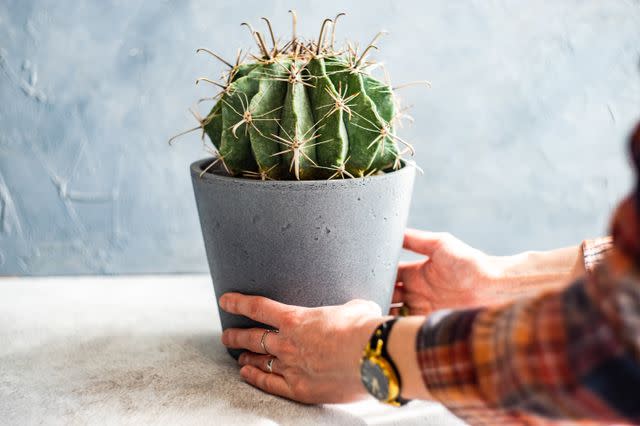
annabogush/Getty Images
“Barrel cactus is a favorite among indoor growers,” Ohler says. “They grow very slowly but can reach an immense size of over 8 feet when cared for properly.” Barrel cactus varieties come from southwest North America. They can vary in size, with some short, rounded, and close to the ground and others that can reach over 9 feet tall.
Pencil Cactus
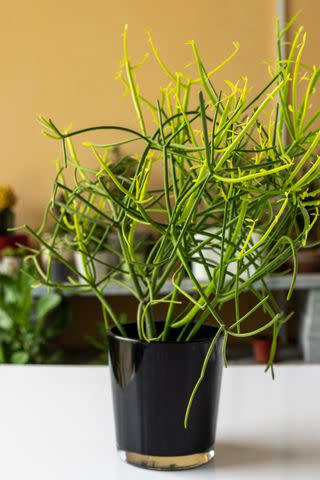
Bilal photos/Getty Images
The pencil cactus is another favorite for indoor spaces. Ohler says these shrubs grow quickly and have no spikes or thorns, making them a family-friendly option for indoor growers. The pencil cactus has thick brown branches with smaller green branches that are cylindrical, in the shape of a pencil. Pencil cactus plants can grow to over 9 feet tall. “Pencil cactus is one of my favorite ones to propagate as it only takes a tiny piece of stem a few weeks to start forming new roots,” Ohler says.
Angel Wings Cactus
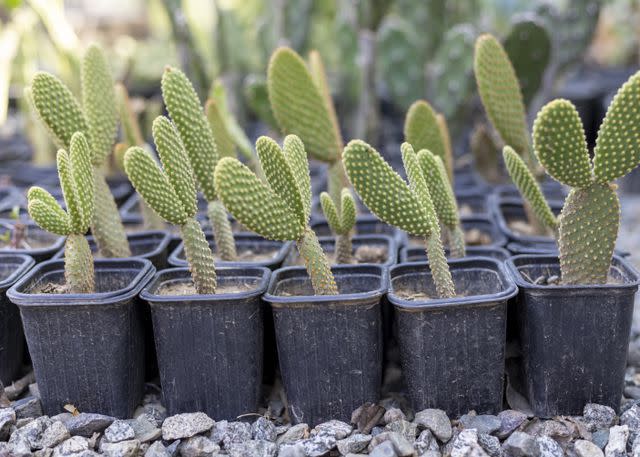
Bilal photos/Getty Images
The angel wings cactus, also called "bunny ears," is a member of the prickly pear family. These cacti are popular for indoor spaces as they usually top out at two feet tall. The angel wings cactus features evenly spaced clusters and fleshy parts, including edible fruit.
Christmas Cactus
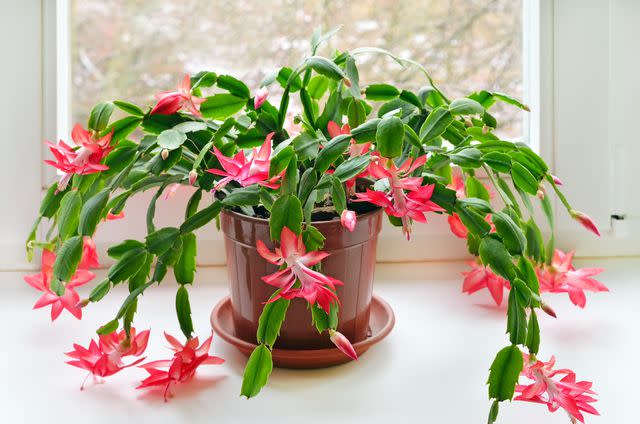
Nadezhda_Nesterova/Getty Images
Another popular indoor cactus is the Christmas cactus, which hails from Brazil and does not have prickly parts. Unlike many cacti, the Christmas cactus has smooth, segmented leaves and soft spines with colorful flowers in red, pink, orange, and white shades. The plant originates in the rainforest and does well with some moisture and cool conditions.
Popular Outdoor Cacti
With so many different species of cacti, these hardy plants can do well in a variety of climates. Here are some popular cactus plants for outdoor landscapes:
Beavertail Cactus
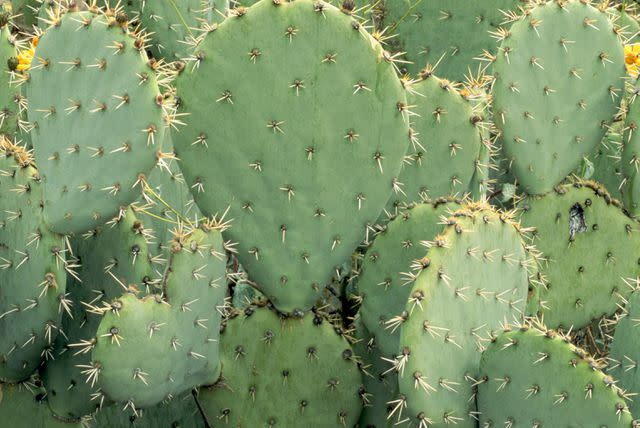
Richard Hamilton Smith/Getty Images
The beavertail cactus—or Opuntia basilaris—is a prickly pear cactus native to the southwestern U.S. and northwestern Mexico. The cactus has many fleshy pads and a bluish-green color. The sprawling plant can grow 6 feet wide and 20 inches tall and thrives in arid environments with plenty of sunlight.
Claret Cup Cactus

PhotoAlto-Jerome Gorin/Getty Images
The claret cup cactus—Echinocereus triglochidiatus—is native to Central and Western parts of the U.S., Ohler says. This cactus can handle cooler temperatures but prefers the dry regions in higher altitudes. The claret cup cactus is common in landscaped areas in regions over 2,500 feet above sea level.
Eastern Prickly Pear Cactus

leekris/Getty Images
If you live in a region with cold winters, some cacti can do well outdoors, even in the cold. “I’m located in Michigan, and we do have a cactus here that can not only survive our cold, harsh winters, but they’re also native to many regions in the Midwest!” Ohler says. “This is the Eastern prickly pear cactus (Opuntia humifusa). This cactus has broad, flat paddles and features bright yellow flowers that bloom in early summer.”
Spinystar
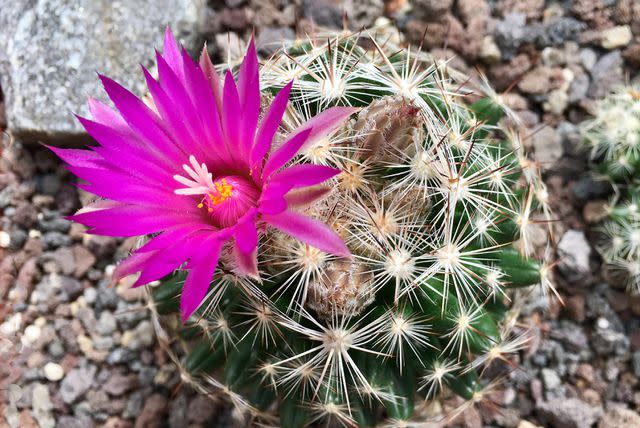
Hermsdorf/Getty Images
Another cactus that can survive cold winters is the spinystar (Escobaria vivipara), a small cactus that grows in round clusters. “This cold-hardy cactus is native to the Great Plains regions and can tolerate cold winters,” Ohler says. “It also features bright pink blooms in the spring and is often used as a slow-growing ground cover in rock gardens and landscaping.”
Creative Uses of Cactus Plants
Cacti are often used for adding unique statement pieces to indoor and outdoor areas. Indoor cactus plants offer serene desert silhouettes and low-maintenance upkeep. Outdoor gardens can save water by planting cacti while evoking a desert vibe. Cacti are popular in outdoor gardens for xeriscaping, the practice of landscaping with slow-growing, drought-tolerant plants to conserve water and reduce yard trimmings.
Medicinal and Culinary Uses
Some types of cactus plants can be eaten, including dragon fruit, prickly pear, barrel, cholla, and saguaro. Prickly pears produce edible fruits perfect for jellies, jams, and juices. The prickly pear is also used for nopales, a common ingredient in Mexican cuisine.
Peyote, a small cactus native to Mexico and part of Texas, is increasingly popular for home gardens and psychoactive effects. Peyote was traditionally used for medicinal and spiritual purposes among Native Americans. The cactus includes mescaline, which causes it to have a hallucinogenic effect on people.
Related: How to Care for a Hoya Heart Plant
For more Real Simple news, make sure to sign up for our newsletter!
Read the original article on Real Simple.


